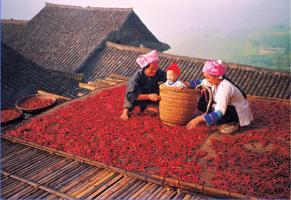Chinese Silk
First developed in China, the shimmering magical fabric known as silk has fascinated people for centuries. Originally reserved for China’s emperors and royal family, silk gradually became available to those who could afford it and became an important part of china’s culture and main trade item on the Silk Road.
The origin of silk is unknown. It is believed that it began in 2600BC, but according to legend, Empress Si Ling discovered silk while drinking tea under a mulberry tree in the imperial palace. A cocoon fell into her hot cup of tea and started to unravel. The empress was amazed at the strength and beauty of the thread and soon it became all the rage in the imperial family. By the 14th century BC, silk production grew into a major industry. The production of silk reached its peak during the Han Dynasty (206BC-220AD). At that time silk was transported along the Silk Road as far as Rome. During the Ming (1368-1644) and Qing (1644-1911) Dynasties, Silk was transported to Europe and America.
China maintained a monopoly on silk for more than 2,000 years. It was illegal to transport silkworm eggs, cocoons, or mulberry seeds and anyone caught doing so was put to death. In 200BC there was a large migration from China to Korea. Mulberry seeds and moth eggs were taken with them and the secret of silk production was out. It then slowly traveled across Asia, with every country adding its own unique styles and culture to the silk products. Eventually silk production made its way to Europe. Even though silk is made throughout the world, China is still the world’s largest producer of silk.
Silk production begins at silk farms where farmers breed silk moths. An adult female moth can lay as many as 500 eggs. The eggs are kept in incubators on special paper until the caterpillars are hatched. The caterpillars are fed on mulberry leaves and when they are approximately 10,000 times heavier than when their birth weight, they will spin cocoons. The cocoons are then taken to the factory to be unwoven into silk thread. The cocoons are then separated by quality and dropped into very hot water to loosen them and they are then unwoven in a single thread which can be as long as 320 feet. The threads are combined with the threads for 6 cocoons to produce a single thread. The thread is then dyed and woven into cloth or carpets.
There is a lot of man-made cloth being passed as natural silk. It is important to make sure what you are buying is authentic. The two main tools used in identifying real silk are your eyes and hands. The silk fibers are long and thin. Silk has a special sheen to it which is bright, but not shiny like man-made material. Another way to test the silk is to burn a thread. The silk will melt and curl and when lit will burn slowly. It also smells like burning hair.
Silk should be dry cleaned or washed with detergent specially designed for washing silk and hand washed gently. Silk should be stored in a dry cool place out of direct sunlight and if you need to iron your silk garments, it is important to do so at a low temperature.

 China Ethnic Minority Tours
China Ethnic Minority Tours.jpg) Prairie & Grassland Camping Tours
Prairie & Grassland Camping Tours.jpg) Family China Tours
Family China Tours 

